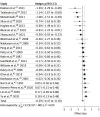Physical Activity Interventions to Alleviate Depressive Symptoms in Children and Adolescents: A Systematic Review and Meta-analysis
- PMID: 36595284
- PMCID: PMC9857695
- DOI: 10.1001/jamapediatrics.2022.5090
Physical Activity Interventions to Alleviate Depressive Symptoms in Children and Adolescents: A Systematic Review and Meta-analysis
Abstract
Importance: Depression is the second most prevalent mental disorder among children and adolescents, yet only a small proportion seek or receive disorder-specific treatment. Physical activity interventions hold promise as an alternative or adjunctive approach to clinical treatment for depression.
Objective: To determine the association of physical activity interventions with depressive symptoms in children and adolescents.
Data sources: PubMed, CINAHL, PsycINFO, EMBASE, and SPORTDiscus were searched from inception to February 2022 for relevant studies written in English, Chinese, or Italian.
Study selection: Two independent researchers selected studies that assessed the effects of physical activity interventions on depressive symptoms in children and adolescents compared with a control condition.
Data extraction and synthesis: A random-effects meta-analysis using Hedges g was performed. Heterogeneity, risk of bias, and publication bias were assessed independently by multiple reviewers. Meta-regressions and sensitivity analyses were conducted to substantiate the overall results. The study followed the PRISMA reporting guideline.
Main outcomes and measures: The main outcome was depressive symptoms as measured by validated depression scales at postintervention and follow-up.
Results: Twenty-one studies involving 2441 participants (1148 [47.0%] boys; 1293 [53.0%] girls; mean [SD] age, 14 [3] years) were included. Meta-analysis of the postintervention differences revealed that physical activity interventions were associated with a reduction in depressive symptoms compared with the control condition (g = -0.29; 95% CI, -0.47 to -0.10; P = .004). Analysis of the follow-up outcomes in 4 studies revealed no differences between the physical activity and control groups (g = -0.39; 95% CI, -1.01 to 0.24; P = .14). Moderate study heterogeneity was detected (Q = 53.92; df = 20; P < .001; I2 = 62.9% [95% CI, 40.7%-76.8%]). The primary moderator analysis accounting for total physical activity volume, study design, participant health status, and allocation and/or assessment concealment did not moderate the main treatment effect. Secondary analyses demonstrated that intervention (ie, <12 weeks in duration, 3 times per week, unsupervised) and participant characteristics (ie, aged ≥13 years, with a mental illness and/or depression diagnosis) may influence the overall treatment effect.
Conclusions and relevance: Physical activity interventions may be used to reduce depressive symptoms in children and adolescents. Greater reductions in depressive symptoms were derived from participants older than 13 years and with a mental illness and/or depression diagnosis. The association with physical activity parameters such as frequency, duration, and supervision of the sessions remains unclear and needs further investigation.
Conflict of interest statement
Figures
Comment in
-
Unlocking the Promise of Physical Activity for Mental Health Promotion.JAMA Pediatr. 2023 Feb 1;177(2):111-113. doi: 10.1001/jamapediatrics.2022.5096. JAMA Pediatr. 2023. PMID: 36595261 No abstract available.
-
Context and Differentiation in Antidepressant Effects of Physical Activity in Children and Adolescents.JAMA Pediatr. 2023 Jun 1;177(6):649-650. doi: 10.1001/jamapediatrics.2023.0505. JAMA Pediatr. 2023. PMID: 37093580 No abstract available.
-
Context and Differentiation in Antidepressant Effects of Physical Activity in Children and Adolescents-Reply.JAMA Pediatr. 2023 Jun 1;177(6):650. doi: 10.1001/jamapediatrics.2023.0508. JAMA Pediatr. 2023. PMID: 37093595 No abstract available.
-
Physical activity and depressive symptoms in youth.Transl Pediatr. 2024 Jun 30;13(6):1007-1011. doi: 10.21037/tp-24-44. Epub 2024 Jun 27. Transl Pediatr. 2024. PMID: 38984025 Free PMC article. No abstract available.
-
On the road to exercise as medicine for depressive symptoms in young people.Transl Pediatr. 2024 Jul 31;13(7):1279-1282. doi: 10.21037/tp-24-152. Epub 2024 Jul 29. Transl Pediatr. 2024. PMID: 39144428 Free PMC article. No abstract available.
References
Publication types
MeSH terms
LinkOut - more resources
Full Text Sources
Medical
Miscellaneous


